The cuneiform system of writing was used most extensively in the ancient Middle East.
Cuneiform was employed for writing a number of languages from about the end of the 4th millennium BC until about the 1st century BC.
The earliest attested documents in cuneiform were written in Sumerian, the language of the inhabitants of southern Mesopotamia and Chaldea from the 4th until the 2nd millennium BC.
Discovered at the site of the ancient city of Uruk (biblical Erech), they were in a pictographic type of cuneiform in which objects were represented by pictures, numbers were represented by the repetitional use of strokes or circles, and proper names were indicated by combinations of pictures used according to the rebus principle; i.e., the pictures were to be interpreted according to their usual pronunciations rather than according to the objects they depicted.
During the 3rd millennium BC the pictures gradually changed to conventionalized linear drawings and, because they were pressed into soft clay tablets with the slanted edge of a stylus, came to have a wedge-shaped appearance.
Earlier cuneiform was written in columns from top to bottom but during the 3rd millennium came to be written from left to right with the cuneiform signs turned on their sides.
At about the same time these changes in the cuneiform writing system were occurring, it was adopted by the Akkadians, Semitic invaders of Mesopotamia, for writing their language. The earliest Akkadian cuneiform inscriptions date from the Old Akkadian or Early Akkadian period (c. 2450 to c. 1850 BC), during which the inscriptions of Sargon, the great ruler of Akkad, were written. Cuneiform continued to be used for writing the Assyrian and Babylonian dialects descended from Akkadian.
Cuneiform was borrowed by the Elamites, the Kassites, the Persians, the Mitanni, and the Hurrians. The Hurrians passed the cuneiform writing system on to the Hittites, who spoke an Indo-European language; cuneiform was also used for the languages (e.g., Luwian, Hattian) spoken in areas under Hittite control.
With the spread of Aramaic as the lingua franca of the Near East in the 7th and 6th centuries BC, the increasing use of the Phoenician script, and the loss of political independence in Mesopotamia with the growth of the Persian Empire, cuneiform came to be used less and less, although it continued to be written by many conservative priests and scholars for several more centuries.
The latest known tablet in cuneiform dates from c. AD 75.
The Old Persian part of the trilingual royal inscriptions of the Achaemenid kings of Persia were the first cuneiform documents to be deciphered. The inscriptions were also written in Elamite, which still has not been completely deciphered and investigated, and Akkadian, which was deciphered as soon as scholars recognized it to be a Semitic language.
Once Akkadian had been deciphered, the complete cuneiform system became intelligible and the other languages written in cuneiform could be read. Sumerian, at first believed to be a special way of writing Akkadian rather than a separate language, was among the last of the languages written in cuneiform to be deciphered.
- Encyclopedia Britannica
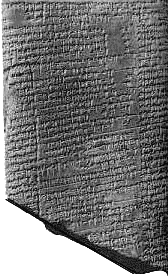
Fragment of a clay tablet from the library of Ashurbanipal at Nineveh, with an Assyrian account of the Flood
In ancient times writing was done on papyrus, parchment, potsherds, and clay tablets. The latter were made of clean-washed, smooth clay. While still wet, the clay had wedge-shaped letters (now called "cuneiform" from Latin cuneus, "wedge") imprinted on it with a stylus, and then was kiln fired or sun dried. Tablets were made of various shapes - cone-shaped, drum-shaped, and flat. They were often placed in a clay envelop. Vast quantities of these have been excavated in the Near East, of which about a half million are yet to be read. It is estimated that 99 percent of the Babylonian tablets have yet to be dug. The oldest ones go back to 3000 B.C. They are practically imperishable; fire only hardens them more. Personal and business letters, legal documents, books, and communications between rulers are represented.
One of the most famous is the Code of Hammurabi, a Babylonian king who lived long before the time of Moses. The tablets reveal intimate details of everyday life in the Near East and shed light on many obscure customs mentioned in Old Testament. Some tell the story of the Creation, the Fall, and the Flood. They do much to verify the truth of the Biblical record.
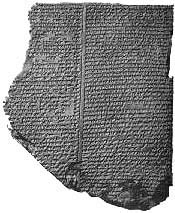
Fragment of a clay tablet from the library of Ashurbanipal at Nineveh, with an Assyrian account of the Flood.
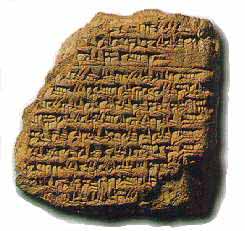
A Babylonian tablet from 87 B.C. repots the arrival of the comet now known as Halley.
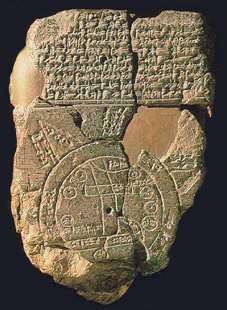
An early world map, circa 600 B.C., shows Babylon as a rectangle intersected by two vertical lines representing the Euphrates River. Small circle stand for surrounding kingdoms, and an ocean encircles the world.
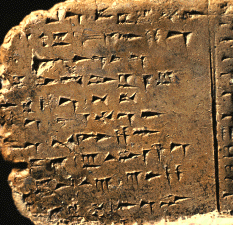
The inscribed clay tablets from the ancient city of Ugarit (ca. 1300 B.C.) are the most important source of information about ancient Canaanite culture that we possess. Not only have they opened an extraordinary door into Canaanite civilization, but they have played an enormous role in gaining an understanding of ancient Israelite religion, since Israel developed out of Canaanite culture.




0 comments:
Post a Comment